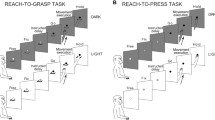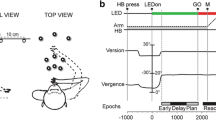Summary
A monkey was trained to make arm movements to visual targets immediately after presentation of a GO signal, either in a visual reaction-time paradigm (CONTROL task), or after an instructed-delay period of variable duration, during which a CUE stimulus signalled the direction of the impending movement (DELAY task). The activity of 98 area 5 cells recorded in 2 hemispheres varied with movement direction in the CONTROL task. This included 60 “early” cells which showed directional activity changes prior to movement onset. In the DELAY task, 54/98 cells (55%) showed activity changes during the instructed-delay period which varied with the direction of the impending movement. Most of these (45/54, 83%) were “early” cells. Forty proximal arm-related cells were recorded in adjacent area 2. In contrast to area 5, only 2/40 area 2 cells showed any evidence of changes in activity varying with intended movement direction during the instructed-delay period. The origin of area 5 activity changes during an instructed-delay period which are related to intended direction of a delayed movement is uncertain, but its presence is consistent with a number of proposed roles for area 5.
Similar content being viewed by others
References
Alexander GE (1987) Selective neuronal discharge in monkey putamen reflects intended direction of planned limb movements. Exp Brain Res 67:623–634
Batuev AS, Shaeffer VI, Orlov AA (1985) Comparative characteristics of unit activity in the prefrontal and parietal areas during delayed performance in monkeys. Behav Brain Res 16:57–70
Bioulac B, Lamarre Y (1979) Activity of postcentral cortical neurons of the monkey during conditioned movements of a deafferented limb. Brain Res 172:427–437
Burbaud P, Gross C, Bioulac B (1985) Peripheral inputs and early activity in area 5 of the monkey during a trained forelimb movement. Brain Res 337:341–346
Chapman CE, Spidalieri G, Lamarre Y (1984) Discharge properties of area 5 neurons during arm movements triggered by sensory stimuli in the monkey. Brain Res 309:63–77
Duffy GH, Burchfiel JL (1971) Somatosensory system: organizational hierarchy from single units in monkey area 5. Science 172:273–275
Favorov O, Sakamoto T, Asanuma H (1988) Functional role of corticoperipheral loop circuits during voluntary movements in the monkey: a preferential bias theory. J Neurosci 8:3266–3277
Hyvarinen J (1982) The parietal cortex of monkey and man: studies of brain function, Vol 8. Springer, Berlin Heidelberg New York, 202 pp
Kalaska JF (1988) The representation of arm movements in postcentral and parietal cortex. Can J Physiol Pharmacol 66:455–463
Kalaska JF, Caminiti R, Georgopoulos AP (1983) Cortical mechanisms related to the direction of two-dimensional arm movements: relations in parietal area 5 and comparison with motor cortex. Exp Brain Res 51:247–260
MacKay WA, Crammond DJ (1987) Neuronal correlates in posterior parietal lobe of the expectation of events. Behav Brain Res 24:167–179
Mountcastle VB, Lynch JC, Georgopoulos A, Sakata H, Acuna C (1975) Posterior parietal association cortex of the monkey: command functions for operations within extrapersonal space. J Neurophysiol 38:871–908
Sakata H (1975) Somatic sensory responses of neurons in the parietal association area (area 5) of monkeys. In: Kornhuber HH (ed) The somatosensory system. Georg Thieme, Stuttgart, pp 250–261
Sakata H, Takaoka Y, Kawarasaki A, Shibutano H (1973) Somatosensory properties of neurons in the superior parietal cortex (area 5) of the rhesus monkey. Brain Res 64:85–102
Seal J, Gross C, Bioulac B (1982) Activity of neurons in area 5 during simple arm movements in monkeys before and after deafferentation of the trained limb. Brain Res 250:229–243
Seal J, Gross C, Doudet D, Bioulac B (1983) Instruction-related changes in neuronal activity in area 5 during a simple forearm movement in the monkey. Neurosci Lett 36:145–150
Sokal RR, Rohlf FJ (1981) Biometry. 2nd edn. WH Freeman, San Francisco
Tanji J, Taniguchi K, Saga T (1980) Supplementary motor area: neuronal response to motor instructions. J Neurophysiol 43:60–68
Weinrich M, Wise SP (1982) The premotor cortex of the monkey. J Neurosci 2:1329–1345
Author information
Authors and Affiliations
Rights and permissions
About this article
Cite this article
Crammond, D.J., Kalaska, J.F. Neuronal activity in primate parietal cortex area 5 varies with intended movement direction during an instructed-delay period. Exp Brain Res 76, 458–462 (1989). https://doi.org/10.1007/BF00247902
Received:
Accepted:
Issue Date:
DOI: https://doi.org/10.1007/BF00247902




